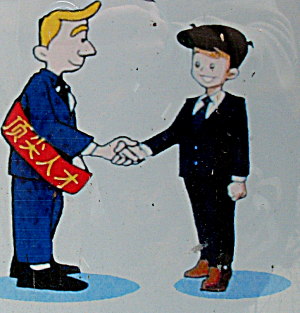- I . GREETING

Greeting is an act of communication in which human beings (as well as other animals) intentionally make their presence known to each other, to show attention to, and to suggest a type of relationship or social status between individuals or groups of people coming in contact with each other. While greeting customs are highly culture- and situation-specific and may change within a culture depending on social status and relationship, they exist in all known human cultures. Greetings can be expressed both audibly and physically, and often involve a combination of the two. This topic excludes military and ceremonial salutes but includes rituals other than gestures.
Greetings are often, but not always, used just prior to a conversation.
Some epochs and cultures have had very elaborate greeting rituals, e.g., greeting of a king.
Secret societies have clandestine greeting rituals that allow members to recognize common membership.
- 1.Greeting gestures
Beyond the formal greeting, which may involve a verbal acknowledgment and sometimes a hand shake, facial expression, gestures, body language and eye contact can all signal what type of greeting is expected. Gestures are the most obvious signal, for instance greeting someone with open arms is generally a sign that a hug is expected.[1] However, crossing arms can be interpreted as a sign of hostility. Facial expression, body language and eye contact reflect emotions and interest level. A frown, slouching and lowered eye contact suggests disinterest, while smiling and an exuberant attitude is a sign of welcome.
Throughout all cultures people greet one another as a sign of recognition, affection, friendship and reverence. While hand shakes, hugs, bows, nods and nose rubbing are all acceptable greetings, the most common greeting is a kiss, or kisses, on the cheek. Cheek kissing is most common in Europe and Latin America and has become a standard greeting in Southern Europe.[2]
While cheek kissing is a common greeting in many cultures, each country has a unique way of kissing. In Russia, Slovenia, Serbia, Bosnia & Herzegovina, Macedonia, Montenegro, the Netherlands and Egypt it is customary to “kiss three times, on alternate cheeks.”[3] Italians & Hungarians usually kiss twice in a greeting and in Mexico and Belgium only one kiss is necessary. In the Galapagos women kiss on the right cheek only[4] and in Oman it is not unusual for men to kiss one another on the nose after a handshake.[5] French culture accepts a number of ways to greet depending on the region. Two kisses are most common throughout all of France but in Provence three kisses are given and in Nantes four are exchanged.[6] However, in Finistère at the western tip of Brittany and Deux-Sèvres in the Poitou-Charentes region, one kiss is preferred. [7]
2.Greeting - Example Conversations
Person A: "Hi, my name is Steve. It's nice to meet you."
Person B: "I'm Jack. It's a pleasure to meet you, Steve."
Person A: "What do you do for a living Jack?"
Person B: "I work at the bank."
Person A: " What is your name?"
Person B: "Jackson."
Person A: "What was that again?"
Person A: " Hey John, how have you been?"
Person B: "What a surprise. I haven't seen you in a long time. How have you been?"
Person A: "I'm doing very well. How about you?"
Person B: "I finally have some free time. I just finished taking a big examination, and I'm so relieved that I'm done with it."
Person A: " Hi Nancy, what have you been up to?"
Person B: "The same ole same ole." Or, "The same as usual. How about you?"
Person A: "I'm pretty busy at work these days, but otherwise, everything is great."
Person A: " Andy, it's been a long time, how are you man?"
Person B: "What a surprise. I haven't seen you in a long time. How have you been?"
Person A: "Do you come to this restaurant often?"
Person B: "I've been here a couple of times, but I don't come on a regular basis."
Comments
Post a Comment